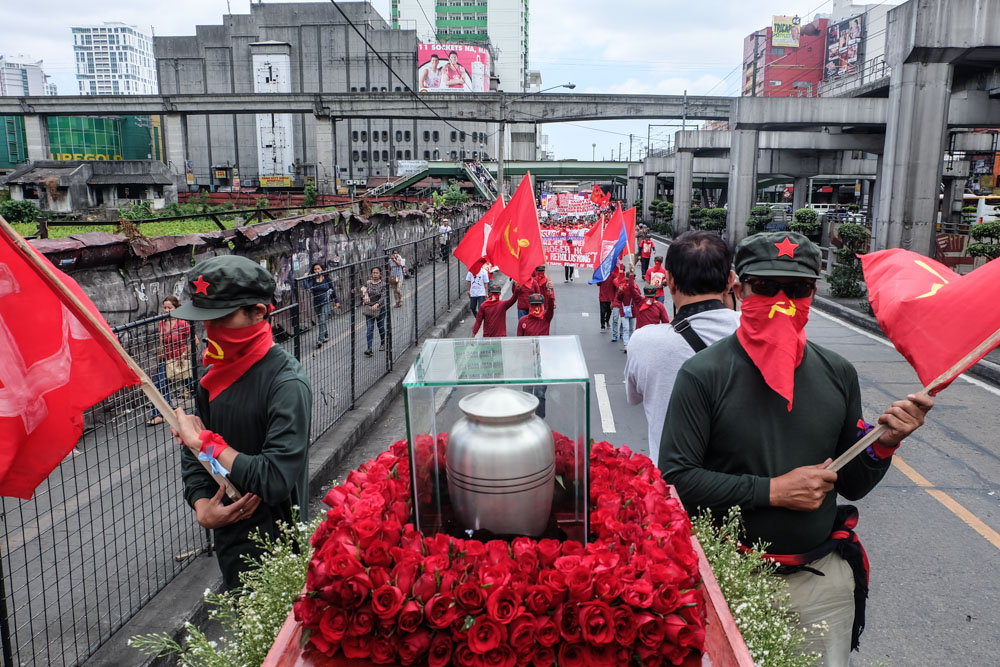His name was Gregorio Rosal. Better known as “Ka Roger”, he would be identified as the voice, the face and spirit of the revolutionary movement. Ka Roger became one of the most enduring icons of the Communist Party of the Philippines (CPP), being its spokesperson since 1994.
A four-day tribute was held in his memory.
According to statement from the CPP, Ka Roger died on June 22, 2011 from a heart attack while in a guerilla zone. He was 64. His remains were buried in an undisclosed location in Northern Luzon. Due to security concerns, his body was not immediately brought to his hometown at Ibaan, Batangas. Five years after, his cremated remains would finally be brought to his hometown, to be interred alongside granddaughter Diona Andrea, who died at birth while her mother Andrea was in detention.
Ka Roger’s ashes were first brought to the Redemptorist Baclaran Church, where the people from Southern Tagalog who accompanied Ka Roger’s remains were warmly welcomed the Redemptorist missionaries, represented by Fr. Teody Holgado.

“Ka Roger emulated Christ by reaching out to the poor and oppressed,” said Fr. Teody.
“May Ka Roger become an inspiration to our countrymen,” he added.
The following day, March 29, a thousand activists, mostly clad in red, marched through Metro Manila’s main thoroughfare EDSA in a bold display of support for the departed CPP icon. (Read more here)

The supporters marched from Cubao to University of the Philippines Diliman Theater, where a program was held in his honor. The tribute was produced by The National Democratic Front of the Philippines – Human Rights Committee in cooperation with Bagong Alyansang Makabayan and the Congress of Teachers and Educators for Nationalism and Democracy.
Philippine revolution icon
Besides being the CPP’s spokesperson, Ka Roger was also involved extensively involved in the peace process, facilitating the release of prisoners of war held by the NPA.

“Ang pinakamataas sa aking katangian niya na dapat nating tularang lahat ay ang kanyang pagiging napakamapagkumbaba sa kabila ng pagiging napakatanyag. (His loftiest trait that we should all emulate was his great humility despite his huge popularity.),” shared Rey Casambre of Philippine Peace Center.
Life as a revolutionary is dangerous in itself. Being designated as the CPP’s spokesperson entailed an even greater risk, with the Philippine government’s penchant for providing huge reward money for wanted dissidents and criminals alike.
He remained elusive throughout most of his career as a revolutionary cadre in the guerrilla zones. A much younger Gregorio Rosal experienced life behind bars once, being detained under Martial Law while as a youth activist. He escaped from Camp Vicente Lim in Canlubang, Laguna along with 9 other political prisoners in 1973.
Despite carrying a bounty of P5 million, Ka Roger carried the role of CPP mouthpiece in stride, media personalities would recall.
Journalist Ed Lingao describes Ka Roger’s efficiency as a communicator.
 “Natuto siyang maging tulay para mapaliwanag ng maigi ang mga prinsipyo niya sa nakararami para lahat sila ay maging Ka Roger din sa kani-kanilang mga komunidad,” said Lingao.
“Natuto siyang maging tulay para mapaliwanag ng maigi ang mga prinsipyo niya sa nakararami para lahat sila ay maging Ka Roger din sa kani-kanilang mga komunidad,” said Lingao.
Ka Roger’s memory rises up to other well-known revolutionaries around the world: Cuba’s Che Guevara, China’s Mao Zedong and Vietnam’s Ho Chi Minh among others—faces who have become popular culture fodder.
Enduring spirit due to continuing revolution
“Not everyone may agree with the NDFP’s alternative vision of Philippine society, but no one can doubt the integrity of your organization’s patriotism or the depth of your commitment to help bring about a more just and a more humane society. That is the same patriotism and commitment Ka Roger embraced,” said a message from Senator Loren Legarda that was read in the program.

Senator Legarda met with Ka Roger for the release of prisoners-of-war held by the NPA.
The voice and face of Ka Roger left a mark not only because of the legend he became, but because of the living and real experiences of the peasants who witnessed or were part of the continuing revolution he embraced up to his death.
Southern Tagalog peasant leader Ka Pido Gonzales attests to Ka Roger’s legacy. Himself a peasant, Ka Roger was amongst the first guerrilla fighters to organize peasants in the Southern Tagalog Region.
“Ang mga magsasaka noon ay kimi. Kapag sila’y inagawan ng lupa, tumatangis ng tahimik sa isang lugar. Subalit ngayon, simula nang matuto at umunlad ang pampulitikang kamalayan ng mga magsasaka sa TK [Timog Katagalugan], kapag kami ay inaagawan ng lupa, kami ay maghahasa ng itak. (Farmers were meek before. When their land is usurped, they would just weep silently in one corner. Nowadays, ever since peasants’ political consciousness were raised, whenever our lands are being taken from us, we would sharpen our knives instead.),” said a feisty Ka Pido.
Ka Pido shared the gains of the collective actions of the farmers to make their living conditions more bearable – lowering land rent, raising crop shares of farmers, defeasance of usuries, seizure of lands, etc.
“Ngayon, tinatamasa na ng mga magsasaka ang mga tagumpay ng rebolusyong agraryo sa kanayunan (Now, the peasants reap the benefits of the agrarian revolution in the countryside),” Ka Pido shared.
As the program ended, a highly invigorated crowd sang the hymn “Internationale” with fists clenched in the air.
Indeed, the revolutionary spirit of Ka Roger lives on.






























